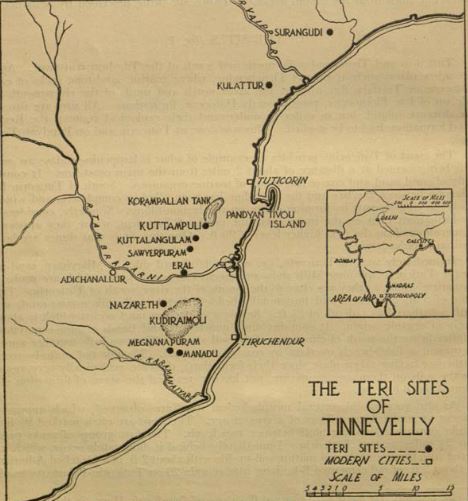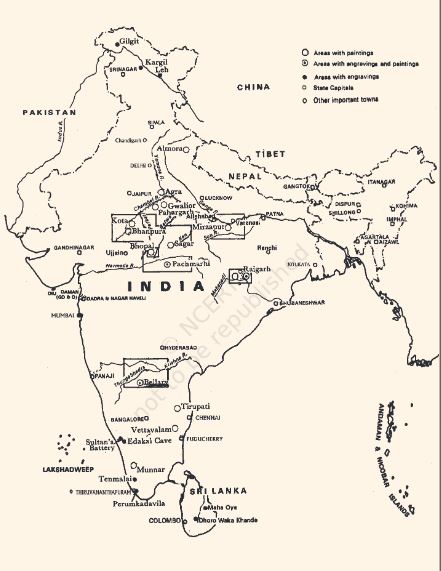Mesolithic Age in India
The date of the Mesolithic culture varies in different parts of the world. We assign this culture to pre-agricultural times in certain areas. In the Levant (Eastern Mediterranean), they are dated between 20,000 and 9500 BCE.
In India, Mesolithic cultures appeared around 10,000 BCE. In certain parts of India including Kerala and Tamil Nadu, it continued up to 1000 BCE, till the beginning of the Iron Age. In Sri Lanka, the microliths appeared about 28,500 years BP.
Mesolithic Sites in India
The Mesolithic culture is found in all eco-zones from the coast to the hills: sand dunes, rock shelters, deltaic regions, lake areas, forested territories, mountainous areas, rocky terrains, and coastal environments.
The Mesolithic sites in India are found in:
- Paisra (Bihar)
- Langhnaj (Gujarat)
- Baghor II
- Chopani Mando
- Sarai Nahar Rai
- Mahadaha, and Damdama (all in Uttar Pradesh)
- Sankanakallu and Kibbanahalli (Karnataka)
Rock shelter sites are found in:
- Lekhakia
- Baghai Khor
- Adamgarh
- Bhimbetka
The coastal sites are found at:
- Mumbai
- Teri sites of Thoothukudy in Tamil Nadu
- Vishakapatnam, which have microlithic evidence.
Teri-A coastal landscape caused by sand dunes. These soils may have originated in the Pleistocene epoch of the Quaternary period.
Teri sites are a group of 11 sites related to the Mesolithic period that are present in the Thoothukudy and Tirunelvelli districts of Tamil Nadu and are associated with dunes of reddened sand. The 11 Teri sites are:
- Megnanapuram
- Kuttampuli
- Kuthankuli
- Sawyerpuram(Sayapuram)
- Kattalankulam
- Kulattur
- Puttan Taruvai
- Surangudi
- Nazareth
- Manadu
- Kayamoli

Climate
After the Ice Age, with global warming, human groups became highly mobile and occupied various eco-zones. The monsoon pattern had already emerged. Some regions witnessed higher rainfall.
At Didwana in western Rajasthan, fresh-water lakes were known to exist between 10,000 and 3500 BP. The animal bones from this period suggest a dry deciduous type of forest during the Mesolithic period.
Chronology
The date of the Mesolithic culture varies in different parts of the world. We assign this culture to pre-agricultural times in certain areas. In the Levant (Eastern Mediterranean), they are dated between 20,000 and 9500 BCE.
In India, Mesolithic cultures appeared around 10,000 BCE. In certain parts of India including Kerala and Tamil Nadu, it continued up to 1000 BCE, till the beginning of the Iron Age. In Sri Lanka, the microliths appeared about 28,500 years BP.
Economy
Hunting wild animals gathering plant food and fishing were people’s major occupations during this age. Agriculture was not practised in the early stages.
At the end of the Mesolithic period, humans domesticated animals and paved the way for the Neolithic way of life. The rock paintings of Central India depict hunting, trapping, fishing, and plant food collection.
The faunal evidence from this period shows that people belonging to this period hunted cattle, gaur, buffalo, barasingha, porcupines, sambar, chital, gazelle, hog deer, nilgai, jackal, turtle, fish, wild hare, lizard fox, and monitor lizard.
We have also found bones of rhinoceros and elephants. They used spears, bows and arrows, and traps. The paintings of Bhimbetka show various animals were hunted and these men and women went together. The people used fire and perhaps roasted food.
At the Mesolithic sites of Loteshwar, Kanewal, Ratanpur, adamgarh, and bhimbetka in Madhya Pradesh, domestic animals such as sheep, goats, pigs, and dog’s bones were found. We have found camel bones from Kanewal.
Camps and Houses
The Mesolithic people were highly mobile and they moved in search of animals and plants for food and made temporary huts and used caves and rocks shelters. We have found circular huts with postholes and burnt clay lumps bearing reed impressions.
Many of the caves and shelters feature paintings. We see circular huts in rock paintings. They built the temporary huts using perishable materials.
We find traces of oval and circular huts and wattle daub in Chopani Mando and Damdama in Uttar Pradesh and Bagor, Tilwara in Rajasthan.
Tilwara mesolithic site
It is historically known as Khedgarh and it is a village in Pachpadra tehsil of Barmer district of Rajasthan. It is located on the Luni River near to Jodhpur-Balotra railway route. This village is famous for the Cattle fair also called the Mallinath fair that March/ April of every year.
Evidence of Cattle distribution found on this site is Zebu(Bos indicus L), Sheep, Goat, Pig, Jackal, etc.
Bagor mesolithic site
Bagor is also present in Rajasthan state in India. It is a town located with a sub-tehsil in Mandal Tehsil of Bhilwara district. The largest Mesolithic site in India is Bagor, which is on the river Kothari.
The earliest settlers at Bagor were hunters and gatherers and there is also evidence of food production in Phase II.
Evidence of Cattle distribution found on this site is Zebu(Bos indicus L), Buffalo, Sheep, Goat, Pig, Wild Boar, Jackal, Fox, etc
Burials
The Mesolithic people buried the dead which suggests their beliefs and humane relationships. We have found human skeletons in Mahadaha, Damdama, and Sarai Nahar Rai in Uttar Pradesh.
Sarai Nahar Rai
It is a village in Uttar Pradesh where the earliest human remains belong to the late stone age site in the Indian Subcontinent. At Mahadaha, a man and a woman were buried together. One burial had an ivory pendant as the grave good.
Art

Art is an integral part of human existence. While we find evidence of art in Europe in large volumes, we find them only at a few sites in India. A chert stone used as a core had geometric engravings from Chandravati in Rajasthan, bone objects from Bhimbetka, and human teeth engraved with geometric designs.
We find rock paintings in the rock shelters of Madhya Pradesh and Central India. They show people hunting, trapping animals, fishing and dancing.
Bhimbetka near Bhopal, Raisen, and Pachmarhi in Madhya Pradesh and South Mirzapur in Uttar Pradesh are some sites.
Haematite, an iron-rich stone with traces of rubbing, has been found. These people might have decorated themselves with flowers and leaves.
Hunter and gatherers of the Historical Period
The hunter and gatherers using microlithic tools continued to live in the later period, even after the development of the Neolithic, Iron Age, and historical periods. Perhaps they became part of the marginalized communities when the people who lived in the cities gained more wealth.
Some people who live in the forests even today in some remote areas and also in the Andaman region could be considered as those people who prefer to live by hunting and gathering.
Many such groups lived in the 19th and 20th centuries, as recorded in Edgar Thurston’s Castes and Tribes of Southern India.
Describing them as primitive is incorrect. We should consider them as people who preferred to live by hunting and gathering. When the Indus Civilization was at its peak, Tamil Nadu had microlithic hunter-gatherers.
The Andhra–Karnataka region had the Agro-pastoralists of the Neolithic period.
Characteristics of the Mesolithic Cultures
The Mesolithic people lived in semi-permanent and temporary settlements. They occupied caves and open grounds. They buried the dead and had artistic skills. Also, they were spread over wider geographical regions.
Cultural continuity is noticed in many parts of India from this period. Their microlithic tools enabled them to hunt smaller animals and birds.
References
- https://asi.nic.in/Ancient_India/Ancient_India_Volume_12/article_1.pdf

